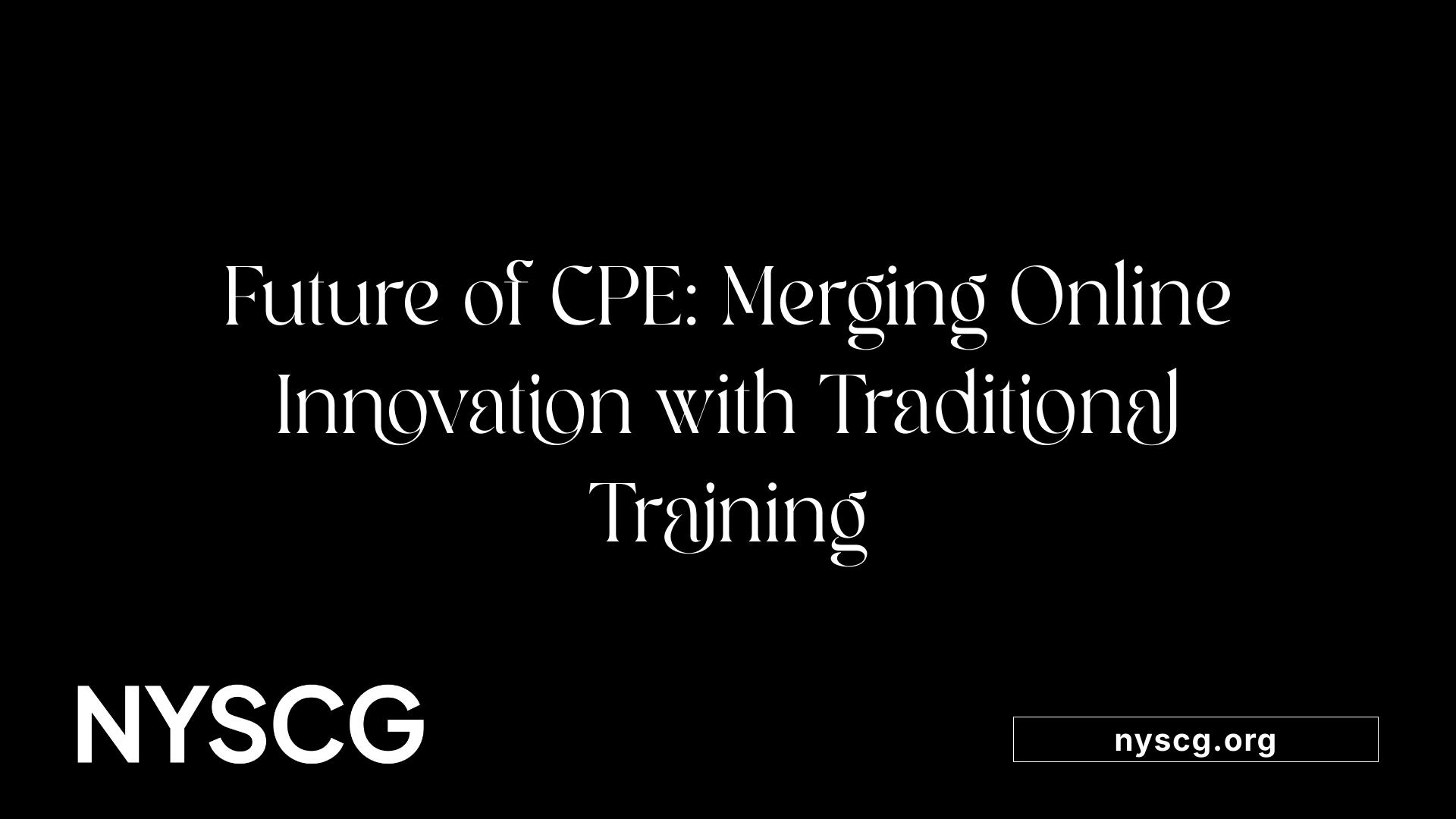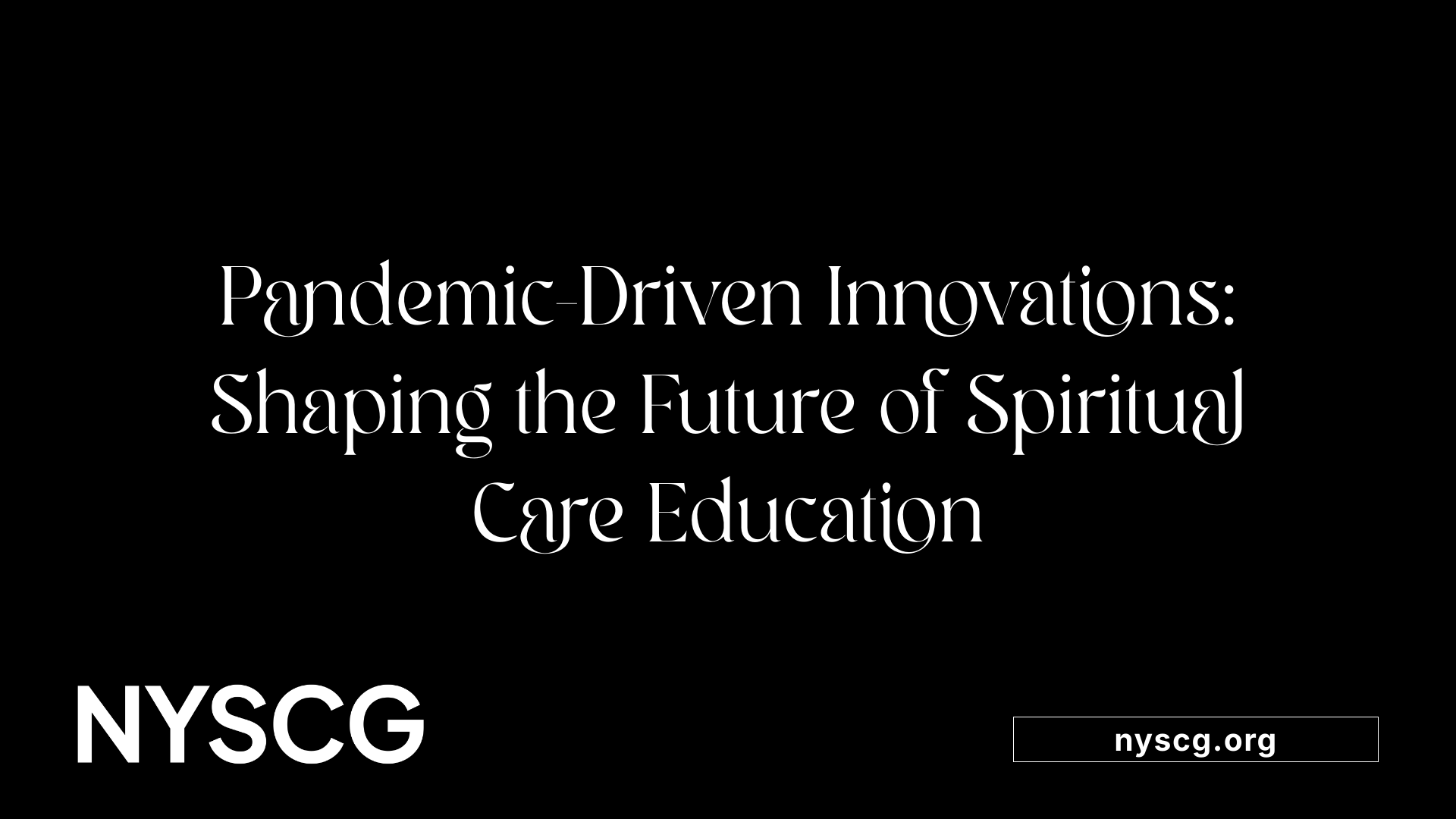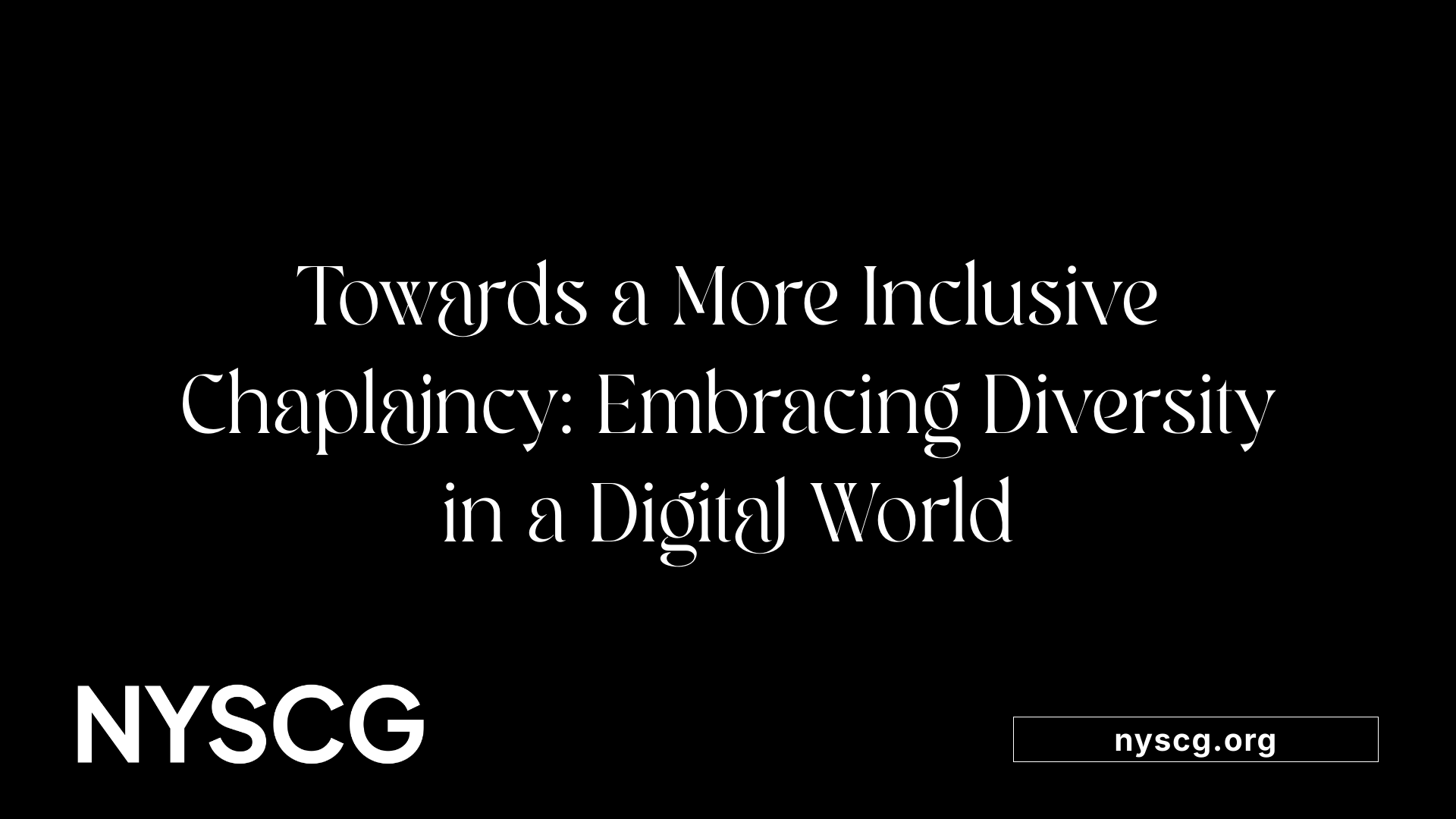How Online Chaplain Training Works in a Post-COVID World


The COVID-19 pandemic has dramatically transformed how chaplaincy training is delivered and perceived worldwide. As institutions pivoted to online and hybrid modalities, they faced both challenges and unprecedented opportunities. This article explores how these changes have reshaped the landscape of chaplain training, the role of technology, and the emerging standards that ensure quality and effectiveness in a post-pandemic world.

The COVID-19 pandemic forced a rapid transformation in how Clinical Pastoral Education (CPE) was delivered. Traditional in-person training was largely replaced by remote modalities, including online classes and hybrid formats that combined virtual and limited face-to-face interactions. Many programs suspended in-person activities, transitioning to digital platforms to continue training students.
Most educators shifted swiftly to support their students through digital means, utilizing video conferencing tools like Zoom for didactics, case discussions, and supervision. These changes not only helped maintain continuity but also prompted a reassessment of what is possible in theological education and pastoral training.
Despite these challenges, educators reported a significant increase in their confidence and competence in delivering remote CPE. They appreciated the flexibility offered by online methods and expressed strong interest in continuing these approaches even after the pandemic subsides.
Remote CPE incorporated both synchronous and asynchronous activities.
Most educators favored live, synchronous sessions because they fostered real-time interaction and immediate feedback. These formats helped simulate some aspects of face-to-face learning, enabling students to engage actively.
Clinical supervision faced particular hurdles as in-person interactions became limited. Many students practiced spiritual care remotely via phone or video calls with patients, families, and healthcare staff.
Supervision shifted to virtual case conferences and digital feedback, requiring educators and students to develop new skills in remote clinical assessment. Although some educators saw a temporary drop in assessment precision, most believed that students could still achieve comparable learning outcomes.
A notable number of educators reported that remote clinical practice increased the opportunity for flexibility and outreach, enabling students to serve broader populations.
Looking ahead, many educators support maintaining remote or hybrid CPE models. They emphasize the importance of establishing standards, providing professional development, and developing resources to ensure quality and accountability.
Technological proficiency, ethical considerations, and maintaining the relational integrity of spiritual care remain critical areas for ongoing training. Despite technological advancements, concerns persist about replicating the depth of human presence and connection in virtual spaces.
In essence, the pandemic accelerated digital innovation in CPE, leading to sustainable changes that enhance accessibility, flexibility, and diversity in pastoral education.
Aspect of CPEMethodologyBenefitsChallengesProgram deliveryOnline, hybrid, in-personIncreased access, flexibility, innovationTechnological issues, assessing group dynamics, ensuring qualitySupervisionVirtual case conferences, remote feedbackBroader outreach, adaptable schedulingMaintaining relational depth, technological competenceStudent outcomesRemote clinical practicePotentially equivalent results, new learning opportunitiesLimitations in face-to-face clinical encountersFuture perspectivesContinued use of remote/hybrid modelsBroader access, innovative practices like telechaplaincyEnsuring standards, maintaining relationality
The shift in CPE delivery during COVID-19 demonstrates resilience and adaptability, heralding a new era of spiritual education that leverages technology to meet diverse needs.

The COVID-19 pandemic prompted a swift shift in Clinical Pastoral Education (CPE) from traditional in-person teaching to remote and hybrid modes. Most educators, who had not previously employed remote methods, quickly integrated online instruction and clinical practice amid restrictions. This transition included delivering didactics, case conferences, supervision, and supervised clinical practice through video calls, phone, and asynchronous modules.
This innovation allowed thousands of students to continue their education despite campus closures. Support from departments and professional organizations, such as ACPE, proved essential. The significance of synchronous activities increased, enabling real-time interaction and peer learning.
In response to the emergency, educators and institutions recognized the need for establishing standards, guidelines, and best practices to ensure quality and accountability. These include clear policies on remote supervision, assessment of group dynamics, and ethical considerations in virtual spaces.
The future of CPE likely involves refining these standards, emphasizing continued professional development for educators, and adopting technological tools that enhance learning. Resources such as online guidelines from professional bodies and shared digital resources are instrumental in this process.
The expedited transition to digital chaplaincy—covering telechaplaincy, virtual religious services, and online support—has underscored the importance of digital literacy. Chaplains now need skills in video conferencing, social media engagement, online resource creation, and understanding digital confidentiality.
Training programs are evolving to include technological competence alongside traditional relational skills. The development of specialized certifications in digital chaplaincy by theological schools is anticipated, equipping chaplains to provide effective care through virtual platforms.
Becoming a chaplain generally requires a combination of theological education, clinical pastoral training, and often a master’s degree in divinity or related fields. While specific requirements can vary by institution and setting, most organizations emphasize competencies in spiritual care, intercultural sensitivity, and some level of ordination or credentialing.
While traditionally, a master’s degree in divinity, theology, or pastoral care is a standard requirement, some pathways exist for non-traditional candidates. Alternate routes include specialized training programs, certification courses, and relevant experiential learning. However, most formal healthcare settings and professional chaplaincy bodies prefer or require graduate-level preparation for credentialing and employment.
Looking ahead, chaplaincy education is expected to incorporate ongoing technology training, expand online and hybrid learning environments, and develop new standards for remote spiritual care. Emphasizing diversity in hiring and inclusive practices, combined with a focus on relational skills in digital platforms, will be central.
Furthermore, integrating lessons learned during the pandemic—such as supporting isolated individuals and working within diverse contexts—will be essential. This evolution aims to create a more accessible, adaptable, and technologically proficient chaplaincy workforce.
AspectCurrent StateFuture DirectionsAdditional NotesDelivery formatsRapid shift to remote/hybridContinued use and refinementEmphasis on synchronous activitiesStandardsEmerging guidelinesFormalization and global standardsResources from professional organizationsSkills requiredRelational and technologicalEnhanced digital literacy and certificationsTraining programs evolvingEntry requirementsUsually master’s degreePotential alternative pathwaysCertifications and specialized trainingImpact of pandemicIncreased acceptance and innovationPermanent integration of remote methodsFocus on accessibility and diversity
The COVID-19 pandemic played a significant role in transforming chaplaincy services by fast-tracking the adoption of digital platforms. As in-person interactions became limited due to safety precautions, many chaplains shifted their work to virtual spaces. They began conducting virtual visits, online prayer sessions, and providing emotional support through social media, email, and video conferencing tools.
Digital chaplaincy now supports a wide range of needs, including offering emotional support to isolated individuals and families, organizing remote memorial services, and engaging communities through livestreamed religious and spiritual events. This shift has opened doors to underserved groups, allowing chaplains to reach people in rural or remote areas who previously lacked access to spiritual care.
Furthermore, the move to digital modalities emphasizes the importance of relational skills—such as empathy and presence—and technological competence. Chaplains are increasingly expected to be adept at using various online tools to provide meaningful spiritual support in diverse contexts, industries, and online communities.
While a master's degree in theology, ministry, or pastoral care is often a standard requirement for many chaplaincy roles, the evolving landscape of digital chaplaincy is broadening the pathways to entering the profession. Some organizations and programs are developing specialized certifications and training programs that focus on digital competencies, pastoral caregiving, and crisis support, which may not always require a traditional master's degree. Nonetheless, foundational education remains highly valued and often necessary for credibility and professional recognition.
Online training is instrumental in equipping chaplains with the skills needed to deliver effective virtual spiritual care. It covers essential areas such as theological knowledge, pastoral communication, and familiarity with digital tools.
Specifically, online courses in digital literacy, videoconferencing, and online pastoral strategies prepare chaplains to handle the unique challenges of remote ministry—such as managing online frustrations and addressing digital anxieties.
Moreover, specialized certification programs focus on telechaplaincy, enabling chaplains to adapt their traditional roles to virtual environments smoothly. These programs emphasize responsiveness, presence, and relationality—core aspects of spiritual care that are crucial even when delivered remotely.
The acceleration in digital chaplaincy activities has expanded the reach and flexibility of spiritual care. Chaplains now not only serve individuals in hospitals, military settings, or hospices but also actively engage with broader communities through social media and online platforms.
As organizations recognize the value of digital chaplaincy, ongoing professional development, standards, and resources are being prioritized to ensure quality care. The digital shift is expected to remain a prominent component of spiritual support, fostering innovative practices like virtual vigils, online religious celebrations, and community engagement through social media.
AspectDescriptionRelevance/ImplicationsDigital PlatformsVideo calls, social media, email, livestreamsExpands access, needs tech literacyTypes of SupportEmotional, spiritual, memorial services, community engagementBroadens service scopeSkills RequiredEmpathy, technological competence, adaptabilityEnsures effectivenessChallengesTechnological difficulties, assessing group dynamics onlineCalls for training and standardsFuture TrendsIntegration into healthcare, industry, university settingsOpportunities for growth
The COVID-19 pandemic fostered an environment where digital skills became essential for chaplains. Training programs are evolving from traditional classroom settings to online modules that simulate real-life scenarios. These efforts are designed to prepare chaplains to meet the spiritual needs of people in a digitally connected world.
In essence, the future of chaplaincy — both virtual and in-person — depends on continuous learning, innovation, and maintaining the relational heart of spiritual care, regardless of the medium.
The rapid shift to remote services during the COVID-19 pandemic accelerated the adoption of various digital tools. Platforms such as Zoom became essential for conducting virtual meetings, didactics, and supervision sessions. Social media channels like Facebook, Twitter, and specialized online platforms also played a significant role in engaging with broader communities and delivering spiritual support.
Video conferencing tools have been utilized not just for education but also for providing virtual visits, support groups, and religious services. Streaming services allowed chaplains to host livestreamed religious events and memorial services, reaching isolated individuals and communities.
These digital platforms are complemented by various other tools designed specifically for spiritual care, such as applications for virtual prayer or meditation, digital resource libraries, and online communication channels for connecting with patients, families, and staff.
Educational institutions and professional bodies have developed comprehensive online curricula, adapting traditional courses into digital formats. These include webinars, sharing circles, and self-paced modules focusing on core competencies like relational skills and theological knowledge.
Supervision and assessment methods have also transitioned to virtual formats. Live supervision via video calls allows educators to observe students’ interactions in remote spiritual care scenarios. Asynchronous assessments, such as reflective essays or case study analyses submitted digitally, support flexible learning schedules.
The use of simulation and role-playing via video enhances practical skills. Many programs now include telechaplaincy training, preparing students for digital and remote care environments.
With the expansion into online education and practice, maintaining high standards is vital to ensure quality and accountability. Accrediting bodies like the ACPE (Association for Clinical Pastoral Education) have issued guidelines emphasizing the importance of technological competence, relational integrity, and ethical practice in digital settings.
Standards include policies on confidentiality, digital boundaries, respectful interactions, and cultural competence. Regular evaluation, peer review, and feedback mechanisms are implemented to uphold quality.
Establishing clear standards helps in credentialing and in safeguarding both patients and chaplains, fostering trust in remote spiritual care.
Tool/AspectFunctionAdditional DetailsZoomLive meetings, supervisionEnables face-to-face interaction and real-time feedbackSocial MediaCommunity engagement, promotionFacilitates outreach and maintenance of online presenceSpecialized PlatformsVirtual prayer, meditation, and careDedicated apps for spiritual practicesCurriculaOnline courseworkWebinars, modules, and case studiesSupervision & AssessmentRemote clinical supervisionReal-time observation, recorded sessions, reflective assignmentsStandards & GuidelinesQuality assuranceAccreditation, confidentiality, technology use policies
While specific requirements vary across institutions, most chaplaincy training programs necessitate a foundation in theological education, often including a master’s degree in divinity or theology. Such programs emphasize relational skills, cultural competence, and the ability to offer spiritual and emotional support.
Generally, a master’s degree is a standard prerequisite for professional chaplaincy. However, some entry points exist for individuals from related fields with equivalent experience or specialized training in pastoral care, especially in non-traditional settings or through credentialing bodies that recognize diverse backgrounds.
The shift towards digital competency has also led to the development of online certifications and specialized training in telechaplaincy, broadening pathways into the profession.
As the field continues to evolve, especially in response to new digital modalities, continual professional development and adherence to established standards remain essential for quality practice and recognition.
In conclusion, the humanitarian and relational nature of chaplaincy work, combined with technological advances, has transformed training and service delivery. Establishing robust standards and leveraging new tools are crucial steps in ensuring that digital chaplaincy remains ethical, accessible, and effective.
Becoming a chaplain generally involves a combination of education, training, and experiential learning. Most chaplains have at least a bachelor's degree, followed by specialized theological or pastoral education. Many also pursue a master's degree in divinity or theology, which provides foundational knowledge and practical pastoral skills. Clinical pastoral education (CPE) is a critical component, offering supervised hands-on experience in providing spiritual care across various settings.
While most professional chaplaincy positions require a master's degree in divinity or pastoral counseling, some entry-level roles may be accessible to individuals with a bachelor's degree combined with significant pastoral or spiritual caregiving experience. However, to meet accreditation standards, participate in certain clinical programs, and advance within the profession, obtaining a master's degree is highly recommended.
During the COVID-19 pandemic, many chaplaincy training programs transitioned to remote modalities due to health restrictions. This shift included online courses, virtual supervision, and remote clinical practice. Educators found that with the right technological tools, students could still meet learning objectives and develop essential skills.
Despite the benefits, remote Clinical Pastoral Education faced notable hurdles. Technological difficulties, such as unreliable internet connections, hardware issues, and platform incompatibilities, hindered seamless communication. Assessing group dynamics became more complex without physical presence, making it harder to observe non-verbal cues and foster group cohesion.
To evaluate group interactions effectively, educators rely on video conferencing features like breakout rooms and real-time polls. They also implement structured observation protocols to monitor participation, engagement, and emotional responses during virtual sessions. Regular feedback and reflective exercises help in understanding group processes and individual learning.
Supervision in remote CPE involves regular virtual meetings, often via secure video platforms. Supervisors review case discussions, role-play scenarios, and reflective journaling to ensure students acquire the necessary skills. Many educators have developed digital resources and recorded sessions to supplement live supervision, maintaining the quality of clinical training.
AspectApproachDetailsAccreditationAdherence to professional guidelinesFollowing standards set by bodies like ACPE.Training ResourcesUsing established protocols and digital toolsEnsuring consistency across remote settings.Supervisor OversightRegular evaluations and feedbackMonitoring student progress and adherence to ethical standards.Technology InfrastructureReliable platforms and technical supportMinimizing disruptions during training sessions.Student AssessmentVirtual assessments and reflective portfoliosEvaluating learning outcomes remotely.
Despite the challenges posed by remote CPE, many educators and institutions have found innovative solutions to uphold quality. They emphasize the importance of establishing clear standards, ongoing professional development focusing on technological competence, and robust support systems for both students and educators.
Ensuring high standards in remote chaplaincy involves continuous evaluation, feedback mechanisms, and adaption of pedagogical strategies. Accrediting bodies are considering updated guidelines to encompass online modalities, ensuring that digital and hybrid training methods meet the same rigorous quality expectations as traditional in-person programs. Training in technological skills, ethical considerations in digital care, and maintaining relational presence virtually are now integral components of professional development.
As we look ahead, embracing this blended approach—with a focus on quality, accountability, and accessibility—can expand the reach of spiritual care training. This approach not only prepares chaplains for diverse environments but also ensures they are equipped to deliver compassionate, competent support whether in-person or through digital means.
The COVID-19 pandemic served as a catalyst for the widespread adoption of remote and hybrid modalities in chaplaincy and Clinical Pastoral Education (CPE). Many programs transitioned swiftly from traditional in-person formats to online and hybrid models, highlighting their practicality and effectiveness. Educators reported increased confidence and competence in delivering remote education, and a strong desire to sustain these methods beyond the pandemic.
Remote and hybrid approaches offer notable advantages, such as increased flexibility, broader access, and innovative practices like telechaplaincy and virtual group activities. These innovations help reach underserved communities and foster professional connections across geographical barriers. The experience demonstrated that students could achieve outcomes comparable to traditional in-person training, despite some challenges.
The expansion of digital tools plays a vital role in shaping future chaplaincy education. Online platforms facilitate didactics, case discussions, supervision, and clinical practice exercises remotely. Educational organizations now recognize online webinars, sharing circles, supervision, and digital resources as fundamental components for ongoing professional development.
These resources enable continuous learning, ensure accessibility, and encourage collaboration among chaplains and educators. Additionally, technological competencies are now considered essential skills for chaplains, preparing them for digital roles in various sectors, including healthcare, military, and community settings.
The concept of telechaplaincy has gained elevated importance, particularly during the pandemic. It involves providing spiritual care through human interaction via online means like social media, email, or video calls. This modality allows chaplains to support individuals facing digital anxieties, frustrations, or needing care in environments where physical presence is limited.
While distinct from artificial intelligence (AI) chaplaincy—which emphasizes human empathy and relational connection—the human element remains central. Chaplains working remotely have engaged in activities such as virtual visits, online prayer sessions, and virtual memorials, offering emotional and spiritual support across various communities.
The field is evolving into a specialized profession requiring relational skills and technological proficiency. The ongoing development of training programs and certifications aims to prepare chaplains for this expanding digital landscape.
Becoming a chaplain generally involves a combination of educational, experiential, and credentialing requirements. Most pathways require a master’s degree in theology, ministry, or a related field, providing foundational theological and pastoral training.
Candidates typically undergo supervised clinical pastoral education (CPE), which includes hands-on training in providing spiritual support in diverse settings. Certification and accreditation often depend on completing specific professional standards, including background checks and ongoing education.
While most formal chaplaincy roles require a master's degree, alternative pathways are emerging, especially for specialized roles like digital chaplaincy or community-based positions. Nevertheless, the standard credentialing bodies emphasize the importance of advanced theological education for comprehensive chaplaincy practice.
The evolving landscape of digital and remote chaplaincy may create opportunities for those with different educational backgrounds, but foundational training remains crucial for ensuring quality, accountability, and the ability to meet diverse spiritual needs.
The future of chaplaincy involves sustained integration of remote modalities, digital resources, and recognition of telechaplaincy as a vital component of spiritual care. Educational institutions will likely develop specialized certifications and training programs tailored to these new modalities.
Overall, chaplaincy training will continue to adapt, emphasizing flexibility, technological competency, and relational skills, all while upholding the core principles of empathy, presence, and support. This evolution aims to meet the needs of diverse populations within healthcare, military, university, and community settings, ensuring accessible spiritual care for all.

The modern chaplaincy field is evolving rapidly, especially in response to the COVID-19 pandemic. A crucial aspect is the push toward building a workforce that reflects the diverse populations it serves. Increasing diversity among chaplains ensures more culturally competent and sensitive spiritual care for patients, students, and staff from varied backgrounds.
During the pandemic, chaplaincy services have shown that different communities have distinct needs, and having a workforce that represents these communities improves access and trust. The goal is to foster inclusivity for faith-based, secular, and non-religious individuals alike.
The landscape of spiritual and religious beliefs is broad and nuanced. Many chaplains now work across major faith traditions such as Christianity, Islam, Judaism, Buddhism, Hinduism, and others. Training programs emphasize understanding these faiths’ rituals, symbols, and values.
Additionally, there is a growing recognition of the importance of supporting non-faith and secular contexts. Secular humanist and spiritual but not religious (SBNR) perspectives are increasingly integrated into chaplaincy roles. This inclusivity ensures that all individuals, regardless of their belief system, feel respected and supported.
The COVID-19 crisis amplified the necessity for chaplains to serve secular individuals and those without religious affiliations. Many people grapple with existential questions like "What does life mean?" and "Will I survive?"—issues that often transcend specific faith traditions.
Chaplains are trained to address these questions with sensitivity, providing support rooted in compassion, reflection, and personal meaning rather than specific religious doctrines. This approach broadens the scope of chaplaincy, making it relevant to a wider array of individuals.
Successful integration of diversity requires robust organizational backing. Funding from religious organizations, healthcare systems, educational institutions, and even large employers is vital. Such support helps create funded positions for diverse chaplains and fosters ongoing professional development.
Professional associations and university programs are also working to promote inclusivity by offering specialized training for chaplains in cultural competence, secular care, and digital skills. This ensures that chaplains are well-prepared to engage with a broad spectrum of faith traditions and secular perspectives.
Most chaplaincy roles necessitate a minimum of a bachelor's degree in religious studies, theology, or related fields. Many positions, especially in healthcare or military settings, also require a master's degree, such as a Master of Divinity (MDiv) or a Master of Theological Studies (MTS). Certification from recognized bodies, supervised clinical hours, a faith endorsement, and relevant experience are also typical prerequisites.
While most roles prefer or require graduate-level education, some entry-level positions or specialized roles may be accessible with a bachelor’s degree supplemented by appropriate experience and certification. The emphasis remains on spiritual maturity, intercultural competence, and the ability to provide compassionate care.
The pandemic has accelerated the adoption of digital platforms for chaplaincy, allowing services to reach distant and underserved populations. To sustain and expand this inclusivity, organizations are advocating for policies that support diversity and digital literacy among chaplains.
Funding for diversity initiatives, expanded training opportunities, and organizational policies that prioritize representation are essential. These efforts ensure that the chaplaincy workforce not only grows in size but also in richness of experience, cultural competence, and ability to serve all segments of society.
AspectCurrent FocusFuture DirectionsAdditional NotesDiversity TypesMajor faith traditions, secular, non-faithBroader representation, including indigenous and minority faithsFocus on cultural competence and sensitivityEducational RequirementsBachelor's and often master's degreesEmphasizing ongoing training in diversity and technologyRecognizing varied educational pathwaysFunding and SupportReligious organizations, healthcare, educationIncreased investment in diversity and inclusion programsAdvocacy for chaplaincy roles in diverse settingsDigital IntegrationRemote services, online presenceExpanding online engagement, multicultural digital contentTraining in technological tools and digital communicationOrganizational PoliciesInclusion policies, certification standardsPolicies promoting equity, representation, and continuous learningAlignment with societal diversity goals
This strategic focus on diversity, supported by organizational commitment, technological advancements, and educational development, positions chaplaincy to better serve increasingly varied communities in this digital era.
As the landscape of chaplaincy training continues to evolve in response to global challenges, the integration of online and hybrid modalities will become central to ensuring accessible, high-quality spiritual care education. Embracing technological innovations while maintaining the core relational and empathetic aspects of chaplaincy will be essential. The post-COVID era offers a unique opportunity to build a more inclusive, adaptable, and resilient chaplaincy workforce ready to meet diverse spiritual needs everywhere.
All you need is the will to make the world a better place.
New York State chaplain group inc. is a tax deductible organization with a federal tax Id number 92-383-4921